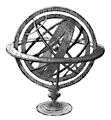![]() Introduction
Introduction
![]() Sources
Sources

| Back to . . . |
This section . . .
|
 Detail of an engraving from The Universal Magazine (1749).    Antikythera mechanism  |
In the first century BC Cicero wrote of two "spheres" built by Archimedes that Marcellus, the Roman consul who conquered Syracuse in 212 BC, looted from Syracuse and brought to Rome. One was a solid sphere on which were engraved or painted the stars and constellations, which Marcellus placed in the Temple of Virtue. Such celestial globes predate Archimedes by several hundred years and Cicero credits the famed geometers Thales and Eudoxos with first constructing them. The second sphere, which Marcellus kept for himself, was much more ingenious and original. It was a planetarium: a mechanical model which shows the motions of the sun, moon, and planets as viewed from the earth. Cicero writes that Archimedes must have been "endowed with greater genius that one would imagine it possible for a human being to possess" to be able to build such an unprecedented device. Many other ancient writers also refer to Archimedes' planetarium in prose and in verse. Several viewed it as proof that the cosmos must have had a divine creator: for just as Archimedes' planetarium required a creator, so then must the cosmos itself have required a creator. Cicero reverses the argument to contend that since the cosmos had a divine creator, so then must Archimedes be divine to be able to imitate its motions. The Greek mathematician Pappus of Alexandria, who lived in the fourth century AD, writes that Archimedes wrote a now-lost manuscript entitled On Sphere-making. Pappus also states that it was the only manuscript that Archimedes wrote on "practical" matters. No physical trace of Archimedes' planetarium survives. Cicero refers to it as a "bronze contrivance" while Claudian describes it as "a sphere of glass." The 1752 engraving of Rowley's orrery suggests how Archimedes' planetarium might have looked. On this orrery the sun, moon and planets revolve along a flat surface driven underneath by a hidden gearworks. Spherical bands surrounding the flat surface represent the celestial equator, the arctic circle, a movable horizon, and the ecliptic marked with the zodiacal signs. In 1900 a shipwreck discovered off the shore of the Greek island of Antikythera uncovered an unexpected treasure. The ship dated from the first century BC and was sailing from the Greek island of Rhodes. Amidst its cargo was a complicated gearworks in a deteriorated state about the size of a cigar box. The device, now called the Antikythera mechanism, was analyzed by Derek De Solla Price of Yale University, who concluded that it was an ancient planetarium in which the positions of the heavenly bodies were indicated by dials on the face of the device. The gearworks are about as complicated as those in a modern mechanical clock and represent the earliest physical evidence of an advanced metallic mechanism. Price gives evidence that this mechanism was in the Archimedean tradition and strongly suggests that Archimedes' planetarium was its forerunner. A complete presentation of Price's research can be found in Gears from the Greeks Celestial globe A sphere on which the stars, constellations, and various astronomical circles are drawn. Celestial globes probably predate terrestrial globes. They are usually mounted in harnesses that allow them to rotate and be tilted to different latitudes.Planetarium A geocentric model of the solar system that shows the positions of the sun, moon, and planets as viewed from the earth at various times. The positions of the heavenly bodies may be indicated by individual dials, as with the Antikythera mechanism, or through the relative positions of small spheres representing the bodies, as with Archimedes' planetarium. Modern planetaria project images of the heavenly bodies onto a large hemisphere in whose interior observers are situated.Orrery A heliocentric model of the solar system in which the planets move about a stationary sun through a clockwork mechanism. Complicated ones can also show the motions of the moons around the various planets and the motion of the rings of Saturn. Named in honor of Charles Boyle, the fourth earl of Orrery, who purchased one of the first such devices built by John Rowley in the early eighteenth century.Armillary sphere A skeletal sphere formed from circular bands that denote the celestial equator, ecliptic, tropics, and arctic and antarctic circles. Usually a ball representing the earth is placed in its center. It is used to demonstrate the motion of the stars about the earth. |